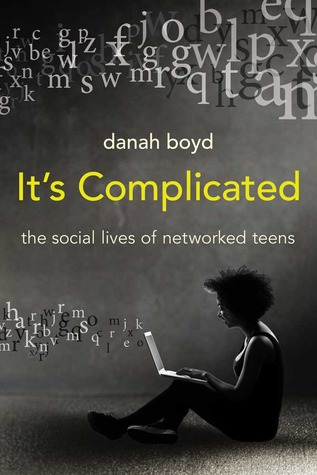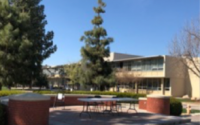Book Review: boyd’s It’s Complicated and Warner’s Adolescents’ New Literacies
boyd, danah. It’s Complicated. Yale UP, 2014.
Warner, Julie. Adolescents’ New Literacies with and through Mobile Phones. Peter Lang, 2017.

Fig. 1: Cover of It’s Complicated, by danah boyd. 
Fig. 2: Cover of Adolescents’ New Literacies with and through Mobile Phones, by Julie Warner.
danah boyd, one of the leading experts on youth culture, studied teen use of social media and other networked technologies from 2003 to 2012. As a result of her extensive ethnographic and qualitative study on teens and her own firsthand experience drawn from working with technology companies bringing social media to the public, boyd began to recognize that teens’ voices about their own engagement in social media were often unheard by parents, teachers, policymakers, and other adults worried about teen engagement with social media. In It’s Complicated, boyd works at giving a voice to teens who often are not being heard. From their stories, boyd concludes that “by and large, the kids are all right. But they want to be understood” (xi).
Julie Warner, a teacher and education scholar, similarly recognizes a trend in teen use of social media but pays particular attention to the role that mobile phones play in this engagement. Through her ethnographic study of three adolescents’ use of mobile phones over a fourteen-month period, Warner aims to understand the role mobile phones play in and out of schooled literacy practices and concludes these various kinds of literacy practices often aren’t in alignment with one another. That is to say that the literacy practices valued in a digital space, such as the digital curation made possible through the use of Twitter, isn’t taught or recognized in schooled literacies. Her book Adolescents’ New Literacies with and through Mobile Phones argues that teachers and schools need to be informed about how mobile phones are used currently and what the affordances of mobile phone technologies are in order to effectively integrate digital literacy learning with mobile phones into classrooms.
These two books complement each other well as each brings their own perspective to larger conversations about the ways youths use social media and the role adults can play in using social media thoughtfully, critically, and safely. boyd focuses her book specifically on the role of social media in teens’ lives, although she acknowledges teens also make use of other networked technologies to support social interaction. Warner, on the other hand, hones in on the intersections with literacies to interrogate what literacies are present in social media engagement and how they might correlate to schooled literacies. Together, these two books present a strong justification for incorporating social media into schooled literacies because youth are engaging with social media and bringing them into schooled literacies allows educators to foster critical thinking and awareness of these technologies. In doing so, youth gain additional perspective on social media not only in their personal lives but also potentially in their future professional lives as they enter into adulthood and the workforce.
One key factor for social media playing such a large role in teens’ lives is tied to social engagement with their peers. As a result, youth are making complex decisions about how to engage within particular discourses. Throughout boyd’s book, she succinctly demonstrates that teens’ everyday uses of these technologies serve as networked publics that allow teens to find their place in society through technological spaces and imagined community when they have other restrictions on their social lives such as busy schedules, lack of mobility, and the fears of parents. Warner, though, provides greater attention to the complex decision-making teens engage in as they consider audience and the affordances of their mobile phone technologies to facilitate this communication, with attention to the use of visuals (emojis, GIFs, photos, etc.) in lieu of or in combination with written text. Pairing these books together further allows parents, teachers, and other adults in teens’ lives to see that their investment in social media isn’t simply about being “plugged in.” Rather, social media serves as a tool for communicating and for teens to begin entering the adult, public sphere in whichever ways possible under the given circumstances. In essence, teens gain crucial practice and experience navigating discourses through making thoughtful decisions about their social media engagement because larger cultural influences (both positive and negative) are often evidenced in social media. This further supports the case for incorporating social media into schooled literacies to provide avenues for supporting teens’ use of social media as they are moving toward adulthood.
The fears of parents, as well as of other adults in society, were a driving factor for boyd’s book, as they have been for others as well. Both boyd and Warner explain that the utopian and dystopian views of technology that lead to technological determinism are detrimental. These arguments reinforce Cynthia Selfe’s arguement for a more complex definition of technological literacy that goes beyond “boon” and “bane” in Technology and Literacy in the Twenty-First Century. Furthermore, pervasive in this mindset is the belief that social media propagates illiteracy due to the use of slang and shorthand. Both authors push back against this assumption as they highlight the highly nuanced and complex interaction that occurs when composing for social media and with mobile phones. The fears and issues, boyd argues, that became apparent through social media (e.g., bullying and racism) are not a result of social media. Instead, “the internet mirrors, magnifies, and makes more visible the good, bad, and ugly of everyday life” (boyd 24). Warner also poignantly addresses this, although not in such explicit terms as bullying and racism, when she discusses how teens learn discourses by studying those that are available to them. Further, she argues, “if the only available discourses in a particular digital space are in some way deleterious, youth may end up engaged in the recirculation of negative discourses” (Warner 158).
One of the main takeaways of both books comes in the form of calling on adults (educators, parents, and others for boyd, and educators, specifically, for Warner) to understand these larger issues through social media so that adults can begin to intervene and help teens learn about these digital literacies. For boyd, this is anchored to navigating public life through social media participation safely, but Warner takes a more critical digital literacy approach and wants teens to be able not only to create content but also to interrogate technologies. These two books together articulate why, broadly, we should be paying attention to technology use. Users of social media content need to be critical of and engaged with these tools rather than passive consumers.
Adults, though, shouldn’t dismiss the important role social media plays in social interaction. In other words, social media can play an integral role in teens’ social lives. Throughout boyd’s book, she emphasizes that communicating via social media is largely a new way of performing the same social interaction that was done in previous generations. This is also evidenced in Warner’s work as she discovers the three teens in her study use social media to connect and bond with their friends. For one teen who moved often, this was a tool to continue friendships after changing cities and schools. boyd explains that through social media, teens “hang out, gossip, flirt, people watch, joke around, and jockey for status,” (98) just as teens in previous generations utilized physical spaces like sock hops, malls, and football stadiums to do the same. Highlighting that the actions associated with social interaction are largely the same across time, although they look different, is much like Dennis Baron’s argument in A Better Pencil, where he describes the evolution of writing as a technology by discussing the replacement of clay tablets with typewriters and then with computers. Baron explains there is resistance with each technological development, yet these technologies are here to stay, and, in order to use them effectively, people must understand the nuances of technology. Both boyd and Warner also advocate the same attitude in their books. Understanding this alternate perspective of social interaction allows readers to understand what teens are doing in these spaces. Rather than demonizing technology or being reminded of the “good old days” of their own youths, the parallels boyd draws between social interaction today and social interaction in past generations is helpful for adults who view the communication ecosystem as being completely different when it is actually quite similar. Alternatively, Warner’s work helps readers see the way teens engage in social forms of writing as they receive “feedback offered in the form of comments, likes, views, or even silence,” which ultimately “shape[s] the kinds of literacy practices and texts young people engage in and produce” (88). Schools often don’t recognize this social interaction as having any value in terms of schooled literacies, but in actuality teens navigate complex systems of interaction through social media. And it is through this social interaction that they develop literacies and composing strategies for their audiences.
Access is another important issue raised in both of these books as both authors acknowledge that while there is increasing access to technologies, this can vary greatly among different demographics. A 2018 study from the Pew Research Center found that 95% of teens have access to a smart phone and 88% of teens have a desktop or laptop at home they can access, but these numbers shift quite a bit as various demographics are taken into consideration (Anderson and Jiang). While such access to technology is valuable, both authors argue simply having access to technology does not equate to teens having the knowledge or skill set to use it effectively. Warner specifically notes that no one is teaching teens how to use these technologies. They are teaching themselves as they use mobile phones and navigate digital spaces. This notion is a point that also comes up in earlier writing studies scholarship, like that of Cynthia Selfe and Stuart Selber, who both point out that simply giving people access to technology in classrooms and homes is not enough for developing technological literacy skills. To that end, Selfe and Selber argue that educators, in particular, are in a position to develop technological literacy. Warner follows in this same vein throughout her book, and boyd calls on parents and other adults to also provide the support necessary for teens to safely navigate public life. boyd makes effective use of one teen’s experience to further highlight the point that teens creating and sharing content online does not mean all teens can critically examine online content, which poses a critical issue for engaging with technology in a meaningful way. boyd identifies one teen who perceived Google as a credible resource for finding information, whereas Wikipedia was not because it could be edited by anyone. Warner goes so far as to argue teens need to become software creators “to get a better sense of how their activities and practices are shaped by the hardware and software that they take up in their literacy practices” (158).
Throughout both of these books, boyd and Warner bring to light the intricate and complex ways adolescents compose and interact socially through social media and mobile phone technologies. boyd’s approach of dismantling myths is strategic as she drives home the point that restricting access to technology did not help teens learn to navigate public life safely. Warner, though, gives a deeper look into the composing practices teens engage in as they participate in social media with mobile phones and as they create multimodal texts through the use of pictures, emojis, and GIFs to communicate, sometimes more succinctly and clearly than what can be conveyed through words alone. Both authors provide valuable resources for better understanding what teens are doing. With that knowledge, adults are better equipped to support teens’ learning and development with social media and mobile phones. boyd and Warner’s research reveals a continued lack of support for teens to critically understand the technologies they use. While Warner reveals they have a sense of audience awareness when composing on social media, they learn this through the sites themselves. Some of what is revealed in boyd’s work, such as stories about teens going behind parents’ backs to use restricted technologies or teens willingly engaging in sexual contact, might be disheartening to read, but she demonstrates how youth continue to need critical digital literacies so they aren’t attempting to figure it out on their own. Early research on technology and literacy has demonstrated the same, but boyd and Warner conclude that there remains a need both in and out of school to support this literacy development further. Ultimately, these literacies should be acknowledged in our schools and thoughtfully integrated into courses rather than including them because of the popularity factor.
Works Cited
Anderson, Monica, and Jingjing Jiang. “Teens, Social Media & Technology 2018.” Pew Research Center, 18 May 2018, www.pewinternet.org/2018/05/31/teens-social-media-technology-2018/. Accessed 14 June 2018.
Baron, Dennis. A Better Pencil. New York, Oxford UP, 2009.
Selber, Stuart. Multiliteracies for a Digital Age. Southern Illinois UP, 2004.
Selfe, Cynthia L. Technology and Literacy in the Twenty-First Century. Southern Illinois UP, 1999.
KEYWORDS: social media, digital literacies, multimodality, access, mobile phones
COVER IMAGE CREDIT:




 Brandy Dieterle completed her Ph.D. from the Texts & Technology program at the University of Central Florida. Her research interests are in multimodal composition, digital literacies, new media, and gender and identity studies. She serves as an associate editor with Kairos: Rhetoric, Technology, and Pedagogy and serves on the editorial review board of Xchanges. Her open access co-authored chapter “Confronting Digital Aggression with an Ethics of Circulation” appeared in Digital Ethics: Rhetoric and Responsibility in Online Aggression, Hate Speech, and Harassment (Eds. Jessica Reyman and Erika Sparby). Her work has also appeared in the Computers and Composition and Composition Forum.
Brandy Dieterle completed her Ph.D. from the Texts & Technology program at the University of Central Florida. Her research interests are in multimodal composition, digital literacies, new media, and gender and identity studies. She serves as an associate editor with Kairos: Rhetoric, Technology, and Pedagogy and serves on the editorial review board of Xchanges. Her open access co-authored chapter “Confronting Digital Aggression with an Ethics of Circulation” appeared in Digital Ethics: Rhetoric and Responsibility in Online Aggression, Hate Speech, and Harassment (Eds. Jessica Reyman and Erika Sparby). Her work has also appeared in the Computers and Composition and Composition Forum.